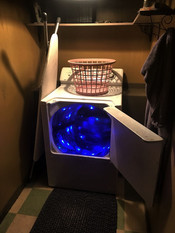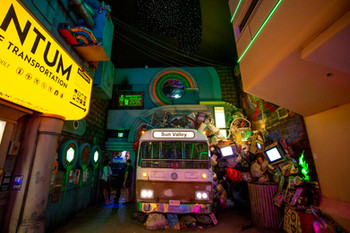Exquisite Corpse: ADR Remix
- Corrina Crazie Espinosa
- Feb 18, 2019
- 8 min read
Updated: Oct 2

ADR stands for Automated Dialogue Replacement, a process where actors re-record their dialogue in a studio to match the video footage of a scene.
You will perform and record new dialogue over an existing video clip (or a short video you shoot yourself with the sound removed). Think of it as giving the footage a whole new life by replacing the soundtrack. Use your new sounds not just to shift, but to completely reinvent the meaning of the original story. The dialogue must be your own (or clearly credited collaborators) and synced to the video as best you can. Add background ambiance and foley to shape the mood and build an entirely new story.
You will also collect 5 unique sounds from your life (5–30 seconds each) and add them to our shared class sound bank. These can be anything—coffee brewing, doors slamming, roommates mumbling. You may also pull sounds from freesound.org or other sources to expand your mix.
All editing must happen in Adobe Audition. It is mandatory that you use effects in the software to alter and sculpt your sounds.
The goal is to experiment with timing, character, and voice to transform the narrative. Whether it turns out dramatic, horrifying, funny, absurd, or just plain weird is up to you.
Final length should be (approx.) 4:33 — can you guess why?
What is Exquisite Corpse?
Exquisite Corpse was invented in 1925 in Paris by the surrealists Yves Tanguy, Jacques Prévert, André Breton and Marcel Duchamp. It was made popular by the Dada movement. Dada Developed in reaction to World War I, the Dada movement consisted of artists who rejected the logic, reason, and aestheticism of modern capitalist society, instead expressing nonsense, irrationality, and anti-bourgeois protest in their works. The art of the movement began primarily as performance[9] art, but eventually spanned visual, literary, and sound media, including collage, sound poetry, cut-up writing, and sculpture.
This is a sound project... but first, let's talk about a toilet...

Who knows what this "art" piece is called, who "made" it, and why it is so important?
is this art?
is this good art?
why or why not?
Meet Marcel Duchamp, and the concepts of ready-made, found object, idea above hand and the authority of the artist.

So.... It Fountain Art?
Is it good art?
Why or why not?
What impact did Fountain have on the art world?
What mentality or mode of thinking was introduced with the readymade?
What impact did Fountain have on the art world?
What is the impact on the contemporary art world?
Does this shift your opinion of the piece?
How is Fountain related to the images below?
Okay, okay... enough about toilets. Let's talk about sound and music....
John Cage
Imagine it's 1952. Before DJs before Remix, before raves and lofi beats, right before the King of Rock and Roll (Elvis Presley) started gyrating his hips and a handful of years before the Beatles started making young girls scream at the very sight of them, before the Doors, Led Zeppelin, Johnny Cash, Pink Floyd, and Frank Zappa-- Long before House, and Techno, and EDM there was John Cage. Take yourself back before music became what it is today, and imagine you are going to a concert. You don't go out much, and you paid a pretty penny for these tickets, you are excited to see and hear a real good musical showcase. Perhaps you have a date, or you are attending with friends and family. Imagine you walk into the theater, take your seat... and this is the show that unfolds before you. What is your reaction. What do you do? What is this all about?
"Everything we do is music." JC
John cage did for music was Marcel Duchamp did for art. He opened the doors for remix, electronic music. Without John Cage music would not be what it is today.

John Cage (September 5, 1912 – August 12, 1992) was an artist, composer, music theorist, and philosopher. He was a pioneer of indeterminacy in music (a composing practice in which some parts of a musical work are left up to chance or to the interpreter's choice. John Cage explained it as "the ability of a piece to be performed in substantially different ways"). Cage was also a pioneer of electroacoustic music, and the usage of musical instruments in a non traditional manner. Critics have credited him as one of the most influential (and controversial) composers of the 20th century.
Cage is most famous for his 1952 composition 4′33″, which is performed in the without the use of deliberate sound; musicians who perform the number don't actually play any notes, but simply sit for the duration specified by the title (4:33). The "song" is not "four minutes and 33 seconds of silence," as is often assumed, but is made up of the sounds of the environment heard by the audience during the performance. The piece challenges the assumed definitions of what makes music and made it a popular and controversial topic both in musicology and the broader aesthetics of art and performance.

"In 1952, it was performed first at Woodstock, N.Y. and many in the audience were indignant. It was in a hall called the Maverick Hall, which is out in the woods near Woodstock, and one could hear the wind in the trees during the first movement - there are three movements altogether. In the second, you could hear some raindrops - it began to rain - and in the third movement, you heard only people who were indignant, and many of whom were walking out. So it made a three movement sonata."
From the MOMA -- "Cage saw silence as a way to attune audiences to the soundtrack of everyday life, to bring them to consider all the sounds around them as music, thus undoing the idea of a hierarchy of sound, opening up the infinite possibilities of ambient sound, and rethinking the very notion of what music is. As a piece of music that cannot be controlled by the composer and which is necessarily different every time it is performed, 4'33" also exemplifies Cage’s interest in using chance as a compositional strategy."
Get the 4'33 App on you phone:
https://www.johncage.org/4_33.html

Cage was also a pioneer of the prepared piano (a piano with its sound altered by objects placed between or on its strings or hammers), for which he wrote numerous dance-related works and a few concert pieces. The best known of these is Sonatas and Interludes.
pictured: Cage preparing a piano, in 1947.Photograph by Irving Penn / © 1947 (Renewed 1975) CondÉ Nast Publications Inc.
In a 1957 lecture, Experimental Music, he described music as "a purposeless play" which is "an affirmation of life – not an attempt to bring order out of chaos nor to suggest improvements in creation, but simply a way of waking up to the very life we're living".
John Cage career and love life-- courage to be true to himself, no matter.
There are many admirable things about John Cage, but one of them is his bravery and courage to stay true to himself no matter what. Frustration was a huge part of Cage’s strives in the music world. He was controversial, and that is a hard path to take. People didn't understand him, they sometimes reacted to his work with baffled terrible reviews and even laughter. He struggled to earn a living and be taken seriously as a composer. For decades, he was his own booking agent and personally asked people to help underwrite his concerts. He struggled valiantly to establish a center for new music at Cornish School, Bennington College, and Mills College—all to no avail. Tellingly, he wrote to young a composer: “I never made enough money [from my music]to live on until I was fifty. Interrupted my music in order to do odd jobs in order to eat, etc.” And yet he persisted, and in doing so he changed the world of music forever.

Not only in his determination to pursue his passion in art and music, which he did diligently and for his whole life long, but also with matters of the heart. John cage was openly gay during a time in American History when being so was beyond difficult, it could be downright dangerous. Now, he didn't talk about it publicly, and he wasn't shouting if from the rooftop, but he embraced his love of choreographer Merce Cunningham, who would be his life long love-- all the way to his death.
"While his public artistic persona was expansive, Cage was reticent about his private life. When asked about his relationship with his life partner, the great choreographer Merce Cunningham, he would often politely reply: “I do the cooking, and he does the dishes.” While openly gay, neither of them chose to discuss their homosexuality publicly." --https://glreview.org/article/when-john-cage-composed-in-words/

During their lives together they were not only lovers but creative partners. Over the years they created many collaborations and supported each others creative careers. There were times when their art lives kept them apart for travel, those times were filled with love letters so beautiful, profound and poetic they have been memorialized in a book. Now that's some relationship goals!
Rain finally came + it’s beautifully cool. Wonder how long it will last. It was marvelous because it started suddenly and then was alternately terrific and gentle.
I think of you all the time and therefor have little to say that would not embarrass you, for instance my first feeling about the rain was that it was like you.
[…]
Love you.
Here is your real inspiration:
Let's discuss this video:
1. What were some important things did you notice in the video?
2. How did people react to Cage and what was his response?
3. What new 2 specific techniques or performative behaviors did Cage introduce to the world here?
4. . Where do you see these repeated in contemporary music culture?
Goal: Create a new audio track for an existing video. Your final piece should be as close to 4 minutes and 33 seconds long as possible (a nod to John Cage’s 4’33”).
Requirements:
Completely Replace the Audio
Do not reuse any part of the original audio.
Do not repeat the same words or dialogue.
Invent entirely new dialogue and meaning for the visuals. Think about how Duchamp transformed the urinal — you are transforming the video’s meaning.
Dialogue
Your new audio must include dialogue that syncs with moving lips.
You must record at least 50%-100% of your dialog.
You may source the other 50% from online resources like freesound.org and https://discordier.github.io/sam/
The lips can belong to any subject (cartoon, animal, human, etc.).
Do your best to match timing and lip movements, but exact syncing doesn’t need to be perfect.
Foley / Sound Design
Include foley sounds (footsteps, doors, rustling, etc.) to support the new world you’re creating.
You may record your own sounds, use the shared folder, or pull from online resources like freesound.org and https://discordier.github.io/sam/
Do not use sounds from the original video.
Theme / Concept
Your piece should have a clear and consistent theme, concept, mood, or emotion.
This is what ties your re-voicing together and gives it artistic integrity.
Music (Optional)
Music is not required.
If you choose to use music, keep it minimal: short snippets only (maximum 10 seconds).
Do not use a full song as background.
Length
Aim for 4 minutes and 33 seconds.
Submission
Upload your finished piece to YouTube.
Share the link on your blog for grading.
Focus on creating a NEW dynamic soundscape for your video, NO MUSIC VIDEOS!
Reading Assignment
Read the following article and respond in a blog post using 250 words, 5 images minimum. Use gifs and vids for a more dynamic aesthetic.





















Comments